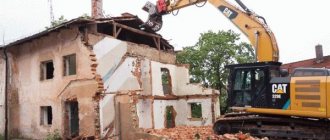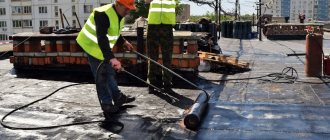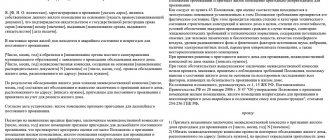What kind of housing is considered unsafe?
Initially, you need to figure out which housing is considered emergency. This is important because it is the occupants who first need to decide whether the house is suitable for living in. This can be easily determined by the following parameters:
- toxicological examination shows the presence of harmful substances above the established level;
- humidity in the house exceeds 60%;
- there is damage to the supporting structure of the building;
- there are no windows in the house;
- the presence of serious damage after an accident, fire and other disasters;
- the location of a residential property in a place where a man-made disaster will soon occur;
- the air temperature does not rise above 18 degrees and remains stable;
- the object is located below ground level (basements and ground floors);
- the house is located next to a landfill, with a highway where the noise level is exceeded, and so on;
- no utilities, etc.
A special interdepartmental commission is responsible for recognizing houses as unsafe. It is guided by the listed factors and Article 32 of the Housing Code of the Russian Federation.
Emergency housing is being demolished. It is assumed that correcting defects at home is impossible. Resident safety is the basis of housing legislation.
How to declare housing unfit for habitation?
If residents believe their home is uninhabitable, they must go through several steps to obtain an assessment. We will describe each moment in detail.
- The homeowner submits an appeal to the interdepartmental commission with a request to recognize the house as unsafe.
- Based on the results of the application, the commission nominates a group of experts to carry out assessment work.
- The interdepartmental commission carries out assessment work as part of a group of experts and draws up a report based on its results in triplicate.
- The status of the house is not indicated in the act; the commission decides this issue later, and after five days it informs the owner of the decision.
- If the house is recognized as unsafe, then all members of the commission will sign a corresponding document about this.
The composition of the commission is decided individually. As a rule, it consists of specialists in the construction field, since only they have the necessary experience in such assessments.
Final decision
After examining the object, the commission makes one of three decision options:
- About the compliance of the house with the criteria for suitability for habitation in its current condition;
- On identifying the grounds to recognize the building as suitable for habitation after major repairs or reconstruction work;
- On identifying the grounds to recognize the house as unfit for habitation and subject to demolition.
This is important to know: General meeting of residents of an apartment building: rules and procedure
If the interdepartmental commission found the house suitable for living, but decided that it needs major repairs, it is worth hastening to implement its instructions. In the case when the residents of the house pay for major repairs, dumping them into a “common pot,” major repairs can be expected for many years, in the order of the official queue. Therefore, it is better to create your account at home and collect money for it. Find out how to open a special account for home renovations here.
The conclusion of the interdepartmental commission is reflected in the drawn up act. A member of the commission who does not agree with the position of the majority has the right to file a written protest (dissenting opinion), which must be attached to the act.
The final decision on recognizing housing as dilapidated and unsafe is made by the municipality, and not by the commission itself. Local authorities are required to notify homeowners of their verdict within five days of the decision.
A person who has filed an application to declare a house unfit for habitation has the right to appeal the authorities’ decision in court. If the municipality or interdepartmental commission fails to act, the complaint is filed with the court or prosecutor's office.
Procedure for obtaining new housing
If the housing is considered unsafe, it is subject to demolition. All residents must first be evicted from such a house. This is done within no more than 2 weeks. The home owner will be involved in the work of the commission.
If everything is clear with the house (instead, an apartment will be issued out of turn), then the question arises with the land. Legislation solved this problem in this way: the state, represented by the municipal body, buys the land from the owner. If this option is not suitable for the owner of the plot for some reason, for example, because of the price, then the municipality will issue a plot of appropriate size in another area.
You need to understand that in the case of municipal housing, things are much simpler - the contract is terminated and citizens are moved according to the new one to the apartment where it is comfortable to live. With your own home the procedure is different. The owner independently carries out such work, and the commission strictly monitors the implementation. Violation of deadlines can result in loss of land.
New housing must meet two parameters:
- be no smaller in area than the previous one;
- be geographically in the same city, town, village, etc.
If, despite the fact that housing is provided out of turn, the municipality delays relocation, the citizen has the right to receive funds in exchange for housing or to apply to the court.
The procedure for recognizing a house as unsafe is quite complicated, but everyone whose living conditions do not meet the standards must go through it. Safety comes first.
The city administration refused to assess my private house, which belongs to me by right of ownership, with a view to recognizing it as unsafe and subject to demolition. The refusal was motivated by the fact that the created interdepartmental commission evaluates residential premises (for suitability) located only in apartment buildings. The interdepartmental commission is not empowered to evaluate private residential buildings. Is such a refusal legal?
According to Article 57 of the Housing Code of the Russian Federation, citizens whose residential premises are recognized in accordance with the established procedure as unfit for habitation and are not subject to repair or reconstruction are provided with residential premises out of turn under social tenancy agreements. In this case, residential premises are provided to citizens registered as needing residential premises.
Thus, the determination of the fact that a private residential building is in disrepair and the recognition of the house (residential premises) as unsuitable for habitation depends on the issue of registering the person - the owner of a private residential building with the local government as needing residential premises and his further resettlement in a suitable place for living. room.
As follows from the analysis of judicial practice, local government bodies often shy away from inspecting private residential buildings to assess their compliance with the requirements for residential premises (suitability or unsuitability for further residence). They refer to the fact that making a decision on recognizing private houses as suitable (unsuitable) for habitation is the right of the local government body, but not an obligation.
However, the Supreme Court of the Russian Federation did not agree with this approach, pointing out in the Review of Practice that the legislator does not provide for any other procedure for inspecting private residential premises in order to recognize them as suitable (unsuitable) for further residence, except for inspection by interdepartmental commissions created at the municipal level.
In case of refusal to assess the suitability (unsuitability) of a private residential building for further residence, you should apply to the court with demands to impose on the municipal administration the obligation to carry out an inspection of the private residential building.
For more information on this, see Section 1 of the Review of Judicial Practice in Cases Related to Ensuring the Housing Rights of Citizens in the Case of a Residential Building being Declared to be Unsafe and Subject to Demolition or Reconstruction,” approved by the Presidium of the Supreme Court of the Russian Federation on April 29, 2014.
We also recommend an answer to the question on the topic: does a citizen whose residential premises are recognized as unfit for habitation have the right to be provided with residential premises on an extraordinary basis?
All unsafe houses are subject to demolition without fail, as they threaten the lives of the residents. For owners of private houses, this is an excellent opportunity to purchase new housing, of higher quality and full-length, at the expense of the state. Let's find out which housing is considered emergency, how to assign this status to a house and which authorities to contact?
Which house is classified as “emergency”?
It is advisable to understand in detail which objects are subject to demolition and which are subject to reconstruction. In most cases, houses that are no longer feasible to repair are considered unsafe. This may be due to technical or economic nuances when it is unprofitable or impossible to carry out restoration work.
Emergency buildings are characterized by poor load-bearing capacity and low performance indicators. This poses a threat to the safety of people and the safety of engineering equipment.
Standard signs of a residential building being in disrepair:
- settlement of the middle part of the structure as a result of soil soaking due to faulty underground communications and drainpipes;
- settlement of the outer part of the house due to an open pit/trenches nearby, construction of a new building nearby;
- settlement of both extreme parts of the object - the presence of a large boulder, an old foundation, a well under the middle of the house;
- bulging and curvature of walls in vertical and horizontal planes.
When a house is considered unsafe, it is strictly prohibited to stay in it.
Criteria for recognizing housing as unfit for habitation
Residential premises fall into disrepair gradually or relatively quickly due to natural disasters. The following grounds are provided for recognizing an apartment building as an emergency:
- Deterioration in the operational characteristics of the building as a whole or its individual parts due to the physical wear and tear of the house. This reduces the level of reliability, strength and stability of the building structure.
The combination of several criteria implies the immediate recognition of an apartment building as unsafe and subject to demolition.
Differences between dilapidated and emergency housing
Emergency apartments are unsuitable for habitation and are almost always demolished. They are located in prefabricated stone, brick, and wooden houses with serious deformations of the foundations and walls. These signs indicate that the building has exhausted its load-bearing capacity. The main reason for deciding to demolish the premises is the high risk of structural collapse.
This is important to know: Dates for holding a general meeting of owners of an apartment building
The main difference between dilapidated housing and emergency housing is the relative safety of living. The house is in poor condition, but not critical.
Residents of emergency premises must be resettled, which cannot be said about the owners and tenants of apartments in a dilapidated building.
Another indicator of how dilapidated housing differs from emergency housing is the percentage of wear and tear. It is determined by an expert commission. To recognize a premises as dilapidated, it must exceed 70%, but to recognize it as unsafe, this is not enough. It must also pose a danger to residents.
In many regions of the Russian Federation, major repairs in dilapidated houses are not provided for with public funds. As a result, residents of worn-out apartment buildings find themselves at a disadvantage: living conditions do not meet standards, but they can live in the building.
The definition of “dilapidated” is not fixed at the legislative level. You can find more information in supporting documents, for example in the “Methodological manual for the maintenance and repair of housing stock MDK 2-04.2004”.
How to recognize a private house as unsafe
This procedure is based on the Housing Code of the Russian Federation and is within the competence of the city administration. In order to recognize a property as unsafe, you need to go through several stages:
- An application is being prepared to the commission for assessing the quality of the residential sector. In the application, the owner must indicate complaints and reasons why he believes that the house is not suitable for habitation. Along with the written application, copies of documents such as a technical passport, floor plans and permission for redevelopment are sent. In addition to the application, you can attach previously written complaints or letters from neighbors or other home owners (if the private sector is divided into several residents).
- Based on the application, an examination of the house and surrounding area is carried out.
The commission will examine the design of the house, the presence and condition of communications, and will also study the quality of building materials and their condition. - An interdepartmental commission reviews the examination and after a while renders a verdict. If, based on the results, the housing is found suitable and safe for living, the owners can contact the executive body to challenge the verdict (within 5 days after the decision is made).
Where to contact?
In order for a private house to be recognized as unsafe, it is necessary to contact an interdepartmental commission that conducts an independent assessment of housing. As a rule, such a commission consists of qualified specialists from Rospotrebnadzor, the housing inspection, as well as the Ministry of Emergency Situations, the city administration and utility services. If it is necessary to challenge the decision, the owner can appeal to the district court.
The procedure for recognizing a house as unsafe: commission
Housing can be considered dilapidated if it is more than sixty-five percent dilapidated. However, after the commission recognizes it as such, there will be no resettlement. You can get a new apartment only when the current housing is considered subject to demolition. Such a decision is made only if the construction of new facilities is planned on the site of a given apartment or private building.
- Carrying out major repairs and reconstruction of an apartment building or other residential premises;
- Recognition of housing as suitable for living in it;
- Recognition of a property as unsafe and subject to demolition;
- Recognition of an apartment or individual private house as dilapidated and uninhabited.
We recommend reading: Certificate of ownership of an apartment 2019
How to get new housing
Resettling residents from dilapidated or dilapidated housing is a long and complex process. To do this, you must have an act from the interdepartmental commission. The resettlement of residents occurs in several stages:
- The private house has been declared unsafe and is subject to demolition. The government agency sets the conditions and timing of resettlement based on the commission’s assessment.
- A package of documents is collected, which includes:
- conclusion of the design organization, where the fact of violation of the structure of the house is proven;
- copies of the owner’s documents (privatization agreement, donation or exchange).
- An order is issued specifying all resettlement procedures and conditions. During resettlement, each owner receives housing of the same size as the emergency one. The state offers the owner two options: receive a redemption amount for the house or a new property. As a rule, the owner does not have the right to choose the area or street of the new home. The first option is very popular, as it includes all the costs of moving, finding a new home, and completing a package of documents.
The queue of evictions is drawn up by the city administration. New housing is issued not only to families living in dilapidated buildings, but also to owners who are included in the program to assist young or large families. Sometimes housing that is subject to demolition can last another 5-10 years until it is time to move out.




